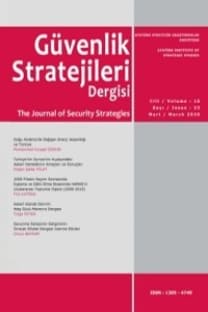Mısır ve Tunus: Devrime Giden Süreçte Goldstone'un İddialarına Yönelik Deneme Alanları
Egypt and Tunisia: Testing Grounds for Goldstone's Assertions on the Revolutionary Process
___
JournalsABOURAHME Nasser and JAYYUS May, “The will to revolt and the Specter of the Real Reflections on the Arab Movement”, City, 2011, Vol: 16, No. 6.
AXFORD Barrie, “Talk About a Revolution: Social Media and the MENA Uprisings”, Globalizations, 2011, Vol. 8, No. 5.
BARRONS Genevieve, “Suleiman: Mubarak decided to step down #egypt #jan OH MY GOD’: examining the use of social media in the 2011 Egyptian revolution”, Contemporary Arab Affairs, 2012, Vol: 5, No. 1.
BODLE Robert, “Assessing social network sites as international platforms”, Journal of International Communication, 2010, Vol: 16, No. 2.
BOUKHARAS Anouar, “The Arab Revolutions for Dignity”, American Foreign Policy Interests: The Journal of National committee on American Foreign Policy, 2011, Vol: 33, No. 2.
CAVATORTA Francesco and HAUGBOLLE Rikke Hostrup, “The End of Authoritarian Rule and the Mythology of Ben Ali”, Mediterranean Politics, 2012, Vol 17, No 2.
CHRISTENSEN Christian, “Discourses of Technology and Liberation: State Aid to Net Activists in an Era of ‘Twitter Revolutions’”, The Communication Review, 2011, Vol: 14, No. 3.
EL AFFENDI Abdelwahab, “Constituting liberty, Healing the Nation: revolutionary identity creation in the Arab World’s delayed 1989”, Third World Quarterly, 2011, Vol: 32, No. 7.
FENTON Natalie and BARASSI Veronica, “Alternative Media and Social Networking Sites: The Politics of Individuation and Political Participation”, The Communication Review, 2011, Vol: 14, No. 3.
GHORI Karamatullah K., “The Arab Spring in Progress”, Pakistan Horizon, 2012, Vol: 65, No 4.
GOLDSTONE Jack A., “Toward a Fourth Generation of Revolutionary Theory”, Annual Review of Political Science 2001, Vol: 4. HOWARD Philip N. and HUSSAIN Muzammil M., “The Role of Digital Media”, Journal of Democracy, 2011, Vol: 22, No. 3.
ISMAIL Salwa, “Civilities, Subjectivities and Collective Action:
preliminary reflections in light of the Egyptian Revolution”, Third
World Quarterly, 2011, Vol: 32, No. 5.
JOFFE George, “The Arab Spring in North Africa: origins and
prospects”, The Journal of North African Studies, 2011, Vol: 16, No 4.
KHOSROKHAVAR Farhad, The New Arab Revolutions that shook
the World, Paradigm, Boulder, 2012.
KIENLE Eberhard, “Egypt without Mubarak, Tunisia after Bin Ali:
theory, history and the ‘Arab Spring’”, Economy and Society, 2012, Vol: 41, No. 4.
LATIF Muhammad Ijaz and ABBAS Hussain, ‘US Democracy
Promotion and Popular Revolutions in the Middle East: Challenges
and Opportunities’, Pakistan Horizon, 2011, Vol: 64, No. 3.
LIPIETZ Barbara and LOPES DE SOUZA Marcelo, ‘Introduction:
Where do we stand? New hopes, frustration and open wounds in Arab
Cities’, City, 2012, Vol: 16, No. 3.
MACQUEEN Benjamin, “The Winter of Arab Discontent”, Global
Change, Peace and Security, 2011, Vol 23, No. 2.
MASOUD Tarek, “The Road to (and from) Liberation Square”,
Journal of Democracy, 2011, Vol: 22, No. 3.
MURPHY Emma C., ‘Problematizing Arab Youth: Generational Narratives
of Systemic Failure’, Mediterranean Politics, 2012, Vol: 17, No. 1.
RANE Halim and SALEM Sumra, “Social media, social movements
and the diffusion of ideas in the Arab uprisings”, Journal of
International Communication, 2012, Vol: 18, No. 1.
ROY Olivier, “The Transformation of the Arab World”, Journal of
Democracy, 2012, Vol: 23, No. 3.
SRINIVASAN Ramesh, “Bridges between Cultural and Digital Worlds
in Revolutionary Egypt”, The Information Society: An International
Journal, 2013, Vol: 29, No. 1.
TARTOUSIEH Karim, “Virtual Citizenship: Islam, culture, and
politics in digital age”, International Journal of Cultural Policy, Vol:
17, No 2. (Mar 2011).
TESSLER Mark et al., “New Findings on Arab Democracy”, Journal
of Democracy, 2012, Vol: 23, No. 4.
TETI Andrea and GERVASIO Gennaro, “The Unbearable Lightness of
Mediterranean Politics, 2011, Vol: 16, No: 2. Internet
BEHR Timo and AALTOLA Mika, “The Arab Uprising Causes, Prospects and Implications”, FIIA Briefing Paper 76, March 2011, www.fiia.fi/assets/publications/bp76.pdf (Access date: September 2012).
ISAAC Sally Khalifa, ‘Europe and the Arab Revolutions’, KFG Working Paper no 39, http://userpage.fu-berlin.de/kfgeu/kfgwp/ wpseries/WorkingPaperKFG_39.pdf (Access date: September 2012).
- ISSN: 1305-4740
- Yayın Aralığı: 3
- Başlangıç: 2005
- Yayıncı: Millî Savunma Üniversitesi Atatürk Stratejik Araştırmalar ve Lisansüstü Eğitim Enstitüsü
Batılı Koloniyel Güçlerin 1994 Ruanda Soykırımına Etkisi
Siber Güvenliğin Milli Güvenlik Açısından Önemi ve Alınabilecek Tedbirler
Mehmet Nesip Öğün Ve Adem KAYA
AVRUPA BİRLİĞİ SİYASİ BİR CÜCE, ASKERİ BİR SOLUCAN MI?
Mısır ve Tunus: Devrime Giden Süreçte Goldstone’un İddialarına Yönelik Deneme Alanları
Mısır ve Tunus: Devrime Giden Süreçte Goldstone'un İddialarına Yönelik Deneme Alanları
